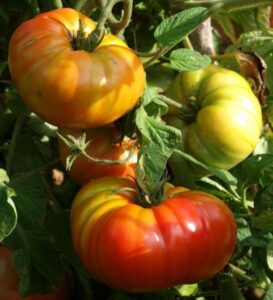Plant of the Month: 5 FAQs on Tomato Harvest and Storage

We can all vouch for the superior taste of home-grown, ripened on the vine tomatoes over those generic, perfectly round and red ones we often find at the grocery store. And now is the season that they’ll start coming on (and quickly too!). Growing your own tomatoes is a lucrative activity, but learning how to properly care for, harvest and store your tomatoes will let you enjoy them at their most flavorful.
1. Why on the vine?
Fully-ripened tomatoes are far tastier than ones that are picked too early. When a tomato is picked too early, it’s sugars continue to convert but they also begin to decay into aldehydes, ketones and alcohols, which deteriorate flavor. This happens because the tomato has been cut off of its steady supply of oxygen, which comes from the stem of the plant. If allowed to ripen on the vine with a steady supply of oxygen, the sugars convert into sweet fructose compounds.
2. How do tomatoes ripen?
There are two main types of tomatoes – determinates and indeterminates. Determinate tomatoes are ones that set and ripen their fruit in a short period of time, usually within 2 to 3 weeks. This will mean that you should prepare for a large harvest, and be ready to can, freeze or dehydrate your tomatoes. Indeterminate tomatoes will continue to set fruit and ripen for the duration of the growing season. You can help the plants set fruit and ripen faster by pinching the suckers (small shoots) off the main stem in early summer.
Tomatoes ripen primarily from heat, not light, and so will continue to ripen on overcast days. In fact, tomatoes may stop ripening if temperatures are consistently above 90 degrees during the day; so pick them before they turn red to avoid sunburn on the skin of the fruit.
3. When should I harvest tomatoes?
The first tomatoes are typically ready within 60 to 85 days of transplanting seedlings out into your garden or veggie patch. Different varieties ripen earlier than others, and your seed packet should inform you of that. You will know that the tomato is ripe for picking once it has turned red, yellow, pink or whichever color the variety is meant to produce. Also look for evenness of color, meaning that one side isn’t green while the other is red, and a bit of softness when you cup the fruit in the palm of your hand. You can harvest tomatoes until the first frost or heavy rains.
Keep in mind that some heirloom varieties ripen before they look ripe or turn color completely. Cherry tomatoes can crack if they are left on the vine for too long, so make sure to pick them slightly before they look entirely ripe.
4. How should I harvest tomatoes?
Be gentle when harvesting tomatoes, and try to keep the top stem of the tomato (green part) on the fruit if you can. This will help the tomato store for longer without a chance of mold or bugs entering through the bare spot at the top of the fruit. Harvest tomatoes into a shallow basket making sure to gently place them in the basket.
5. How should I store tomatoes after harvest?
Tomatoes are very delicate fruits, and so do tend to go off fast if picked at the peak of their ripeness. If you plan on using your tomatoes within a day or two of picking, store them at room temperature but out of the direct sun. If you are trying to store your tomatoes for a few days, store them in a basket or other aerated container in a moderately cool (like a stone floor) environment without too much sunlight. NEVER store your tomatoes in the refrigerator, as this damages the membranes inside the fruit walls and causes the fruit to develop a mealy texture and lose flavor.
Image: Myrtle Glen Farm

